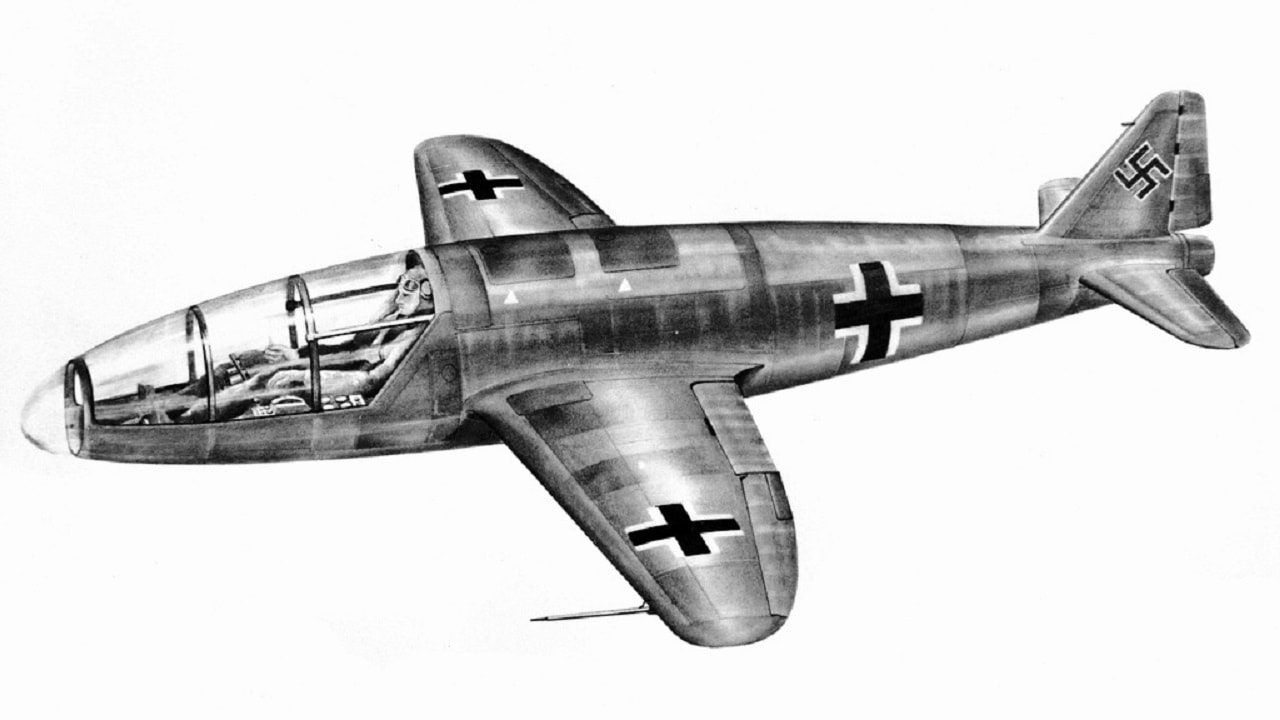The Messerschmitt Me 163 Komet (“Comet”) bears the distinction of being the world’s first operational rocket-powered fighter plane. The Me 163 wasn’t, however, the first rocket-powered airplane. That honor goes to the Me 163’s predecessor, albeit from a competing manufacturer within the same Teutonic country of origin: the Heinkel He 176, the world’s first successful airplane to fly solely on the power of a liquid-fueled rocket engine.
Heinkel He 176 Initial History and Specifications
The He-176 made her maiden flight on June 20, 1939, less than three months before the commencement of World War II via Nazi Germany’s invasion of Poland. The plane was one of the brainchildren of German aviation designer and pioneer Dr. Ernst Heinkel (1888-1958), known for his obsession with high-speed aircraft. Herr Doktor Heinkel’s company, Heinkel Flugzeugwerke, was founded in 1922 and also produced the He 178 – the world’s first turbojet aircraft – and the He 111 – the Luftwaffe’s mainstay bomber for the first four years of WWII, including the Battle of Britain – and before eventually going defunct in 1965.
The design wasn’t entirely Dr. Heinkel’s idea, as it originated from a 1935 proposal by Major Wolfram von Richthofen – a cousin of Manfred Von Richthofen aka The Red Baron, WWI’s ace of aces – to develop a rocket-powered bomber interceptor. The design was begun in earnest in 1936, and detail work was wrapped up by July 1937, when prototype construction began at Heinkel’s Rostock-Marienehe plant.
Specifications included a fuselage length of 17 feet 1 inch, a wingspan of 16 feet 5 inches, a height of 4 feet 8.5 inches, an empty weight of 1,985 pounds, and a gross weight of 3,572 lbs. Max airspeed topped off at a somewhat underwhelming 435 miles per hour (378 knots). According to Brian R. Baker of International Plastic Modelers’ Society/USA (IMPS/USA), “The engine was a Walter HWK R1 rocket which produced approximately 1100 to 1325 pounds of thrust, which exhausted through a small tailpipe. The cockpit had a glass nose, and strangely, a windscreen rather than a canopy.”
Field-Testing Performance and Legacy
That maiden flight of the He 176 was conducted by the same test pilot who put the He 178 through its paces, that being Flugkapitan (Flight Captain) Erich Warsitz. In another coincidental parallel with the ‘178, the next day Warsitz performed a demonstration flight in the ‘176 for the same Reichsluftfahrtministerium (RLM; Ministry of Aviation) senior leaders who ended up pooh-poohing the ‘178: Generaloberst (Colonel General) Ernst Udet – who had been Germany’s second-highest scoring air ace during WWI – Generalfeldmarschall (General Field Marshall) Erhard Milch, and engineer Helmut Schelp. Just as with the He 178, these bigwigs were unimpressed with the He 176. Besides that aforementioned underwhelming speed, there were issues with the rather noisy execution and inherently dangerous nature concerning the combustible fuel. In addition, the airframe proved too heavy for the intended rocket powerplant, and the wing surface area – 58 square feet – was deemed too small for the necessary lift and control at expected speeds.
It was the Me 163 that would end up making air combat history from a rocket plane’s standpoint.
Where Is It Now?
Well, you won’t be able to find the genuine He 176 anywhere, for reasons explained by an anonymous staff writer for the MilitaryFactory.Com website: “The He 176 was sentenced as a museum piece, being sent to Berlin from Heinkel for public display in 1942. However, the Allied bombing campaign saw to it that the German capital was not out of its reach and responded accordingly, the He 176 being destroyed [in] in air raid during 1943.”
In addition, All documents regarding the He 176 were destroyed during the war, and only two verifiably bona fide photographs of the He 176 have survived.
At least in the case of the He 176’s turbojet counterpart, the He 178, you can find a full-size replica on static display at the Planes of Fame Air Museum in Chino, Calif. But with the ‘176, no such luck as far as I’ve been able to ascertain; if any of our dear readers know otherwise, please let us know below in the Comments section! Otherwise, it looks like my fellow military aviation history buffs will have to settle for living vicariously through scale models such as the Jach brand 1/72 scale plastic model kit or the one from 12 Squared brand (the advert gives conflicting information as to whether it’s a 1/72 or a 1/48 scale).
Christian D. Orr is a former Air Force Security Forces officer, Federal law enforcement officer, and private military contractor (with assignments worked in Iraq, the United Arab Emirates, Kosovo, Japan, Germany, and the Pentagon). Chris holds a B.A. in International Relations from the University of Southern California (USC) and an M.A. in Intelligence Studies (concentration in Terrorism Studies) from American Military University (AMU). He has also been published in The Daily Torch and The Journal of Intelligence and Cyber Security. Last but not least, he is a Companion of the Order of the Naval Order of the United States (NOUS). In his spare time, he enjoys shooting, dining out, cigars, Irish and British pubs, travel, USC Trojans college football, and Washington DC professional sports.

